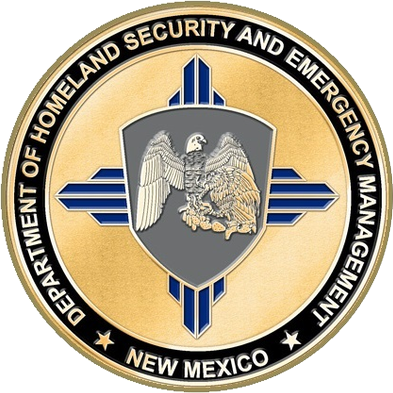WIPP
The Waste Isolation Pilot Plant

WIPP The Waste Isolation Pilot Plant (WIPP), the nation’s repository for “defense-related” transuranic wastes, received its first shipment of non-mixed transuranic waste on March 26, 1999. The shipment was made from Los Alamos National Laboratory. As other generator sites become certified, wastes generated from research, development and production of nuclear weapons at DOE sites across the country will be shipped to WIPP, 26 miles southeast of Carlsbad, New Mexico. A campaign of approximately 38,000 shipments is expected to continue for over 35 years
The State of New Mexico has been working since 1989, internally and with a coalition of western states through the Western Governors’ Association, to develop a transportation system whose goal is the safe and uneventful transport of radioactive materials through western states. The WIPP Transportation Safety Program is a cooperative effort among the shipment-corridor states, tribes, local officials and the DOE. The program goes beyond what is required by law and has been proven through actual use in other radioactive waste shipping campaigns. There is not a shipment on the road that will have undergone as much scrutiny by transportation safety specialists as WIPP shipments. In a July 1989 report, the prestigious National Academy of Sciences WIPP Panel said, “The system proposed for transportation of TRU waste to WIPP is safer than that employed for any other hazardous material in the United States today and will reduce risk to very low levels.”
The Waste Isolation Pilot Plant, or WIPP, safely disposes of the nation’s defense-related transuranic radioactive waste. Located in the Chihuahua Desert, outside Carlsbad, N.M., WIPP began disposal operations in March 1999.WIPP is a U.S. Department of Energy facility and is managed by Washington TRU Solutions.
The Waste Isolation Pilot Plant, or WIPP, safely disposes of the nation’s defense-related transuranic radioactive waste. Located in the Chihuahua Desert, outside Carlsbad, N.M., WIPP began disposal operations in March 1999.WIPP is a U.S. Department of Energy facility and is managed by Washington TRU Solutions.
WIPP WORKING GROUP
- The WIPP Working Group (WWG) is comprised of classified staff at each of the six agencies that participate in the Radioactive Waste Consultation Task Force and is the primary vehicle for the collaborative management of the WIPP Transportation Safety Program. New Mexico Department of Homeland Security and Emergency Management (DHSEM) responsibilities include:
- Tracking of equipment and its calibration
- Arranges for, organizes, & runs WIPPTRAX exercises
- Sets up Radiological Training classes for WIPP route communities’ first responders
- Runs state Commercial Equipment Direct Assistance Program (CEDAP) which provides radiation monitors and other equipment to fire departments with training in equipment use
- Assists other WIPP Working Group members in the trainings they provide
- Tracks high level radioactive materials shipments through the state & notify Task Force members of the shipments.
- DHSEM liaison to Western Governors Association
- Manage the new WIPP personal Radiation Detector program
The New Mexico Department of Homeland Security and Emergency Management WIPP program has the responsibility for the following areas:
Emergency preparedness is a significant part of the WIPP Transportation Safety Program. While the shipments are conducted in such a way as to prevent accidents from occurring, if one does take place, local responders will be prepared to respond quickly, safely and effectively. Due to an expanded role of WIPP to transport Remote Handled Waste (RH) a new campaign of training for response and recovery of an incident has began.
 Emergency Response Plans and Procedures. A well organized and coordinated effort is necessary to make response to an accident swift and effective. Plans and procedures specifically designed to deal with transportation incidents involving the WIPP shipments are in place. The State of New Mexico has prepared several guidance documents which specify notification, incident command, and response procedures for use in the event of a WIPP accident.
Emergency Response Plans and Procedures. A well organized and coordinated effort is necessary to make response to an accident swift and effective. Plans and procedures specifically designed to deal with transportation incidents involving the WIPP shipments are in place. The State of New Mexico has prepared several guidance documents which specify notification, incident command, and response procedures for use in the event of a WIPP accident.
Mutual Aid Agreements. The State of New Mexico has developed written agreements with DOE and the states of Arizona, California, Colorado, Nevada, and Utah to enhance any response to a WIPP accident, as well as to provide assistance for across state borders.
Training, Drills & Exercises. In coordination with DOE, the State of New Mexico has developed a WIPP-specific training regimen for emergency responders, which is incorporated directly into hazardous materials training programs for fire fighters, police and emergency medical staff along the routes. Hospital emergency room personnel also have been trained. Drills and exercises supplement the training.
Emergency Response Equipment. Radiation detection and personal protection equipment has been provided to emergency responders along the initial planned shipping routes in New Mexico. Responders have been trained to properly use this equipment in the event of an incident involving a TRUPACT. Currently the mission of DHSEM WIPP program is to upgrade its Radiation Meters currently assigned to first responders and implement a Personal Radiation Detector program to include purchase, trainings and protocols.





